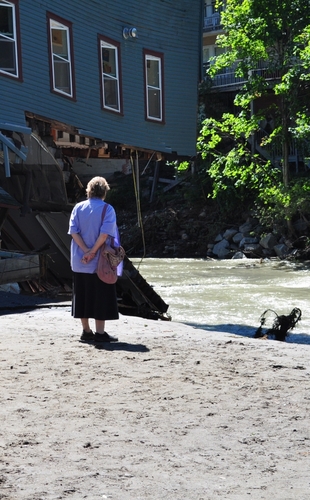It was the rain, not the wind, that caused havoc.
It was a storm we knew was coming to Vermont, and we also knew that there was a high probability of damage and possible loss of life.
Irene was a big storm that was coming to a state that hadn't seen a sizable tropical storm or hurricane in years.
But when Irene passed over Vermont - by then, downgraded from hurricane to tropical storm - on Sunday, Aug. 28, 2011, it seemed almost benign. The high winds never arrived. There was rain that was heavy at times, but how much damage could it do?
As it turned out, an enormous amount of damage.
Up to seven inches of rain fell in a matter of hours on soil that was already saturated by a rainy summer. Soon, normally placid streams and rivers - the Whetstone in Brattleboro, the Rock River in South Newfane and Williamsville, the West River in Jamaica, the Saxtons and Williams rivers in Grafton and Rockingham, the Deerfield River in Wilmington - turned into raging torrents.
If you lived by these rivers and streams, your world was turned upside down.
By that afternoon, Flat Street in Brattleboro was flooded, as was Melrose Terrace and the Glen Park mobile home community. Houses were swept away in Jamaica and South Newfane. Downtown Wilmington saw more water than the historic Great New England Hurricane of 1938. Even the Connecticut River, tamed by flood-control dams built since the big floods of the 1930s, overflowed its banks in Westminster.
Seven people died due to the storm, and a state was left reeling from an epic disaster.
Dozens of bridges and 500 miles of state highways were torn apart. Utility poles and the electrical and telephone lines that hung from them disappeared in some Vermont towns, scoured clean by a torrent of water.
Thousands of homes, businesses, and public buildings were damaged or destroyed, and 20,000 acres of farmland were flooded.
The next day, the skies were blue, the sun was warm, and depending on where you were in Windham County, it was a splendid late-summer day.
But if you were on Flat Street in Brattleboro, you saw almost a foot of mud on the street left by the flood waters.
If you were in downtown Wilmington, you saw miles of yarn washed out from a nearby shop that twisted around a pergola that survived the flood.
If you stood on the Chesterfield Bridge, you saw a parade of logs, propane tanks, and other debris being swept down the rain-swollen Connecticut River.
If you were in Wardsboro, you were totally cut off from the world, with no phone or electric service and no passible roads into town. Supplies had to be airlifted into that community.
Jamaica was similarly cut off, as the Water Street Bridge over Route 30 washed away.
* * *
But in the midst of all that destruction, we saw the generous, resourceful, resilient, never-say-die spirit of this brave little state of ours shine brightly in days, weeks, and months that followed.
We saw a devastated transportation network made whole again within three weeks, thanks to the teamwork between the workers of the Vermont Agency of Transportation, augmented with highway crews from other states, the National Guard, and local contractors.
We saw utility crews quickly restoring electrical service under impossible conditions, also augmented by crews from around the Northeast.
We saw volunteers offering their services all across the state almost as soon as the flood waters receded.
The speed of the recovery from Irene astounded outside observers, but for Vermonters, it was just doing what was what necessary and right for their friends and neighbors.
* * *
You can still see the scars from Irene around Windham County, five years after the storm. Clues turn up in the form of the still-ravaged riverbanks in Halifax and the new gauge on the Wilmington Town Hall, permanently marking the water level at the peak of the Deerfield's rage, higher than the flooding in the Hurricane of 1938.
Those scars are fading as the years pass. The trauma, grief, and distress experienced by so many Vermonters over the destruction - that dissipates over time, too.
But the memory of Vermonters coming together to help their neighbors in a time of crisis will never fade.
As we move into an election season that promises intense and spirited debate about the role, function, and cost of state government, as we move into new and uncertain times for our country, let us remember this spirit that pervaded Vermont in the aftermath of Irene.
In that calm after the storm, the big things suddenly became the little things. In that calm after the storm, people distributed water not caring who was for or against Vermont Yankee. In that calm after the storm, town politics and petty squabbles became hollow and inane.
Not to say these things won't matter, especially in a season of impending state and national elections that threaten to bring out the worst in us.
May we have those debates and discussion and debate in a way that brings out the best in us.
And may it not take another devastating act of nature to prove to us that it is indeed possible to do so.
